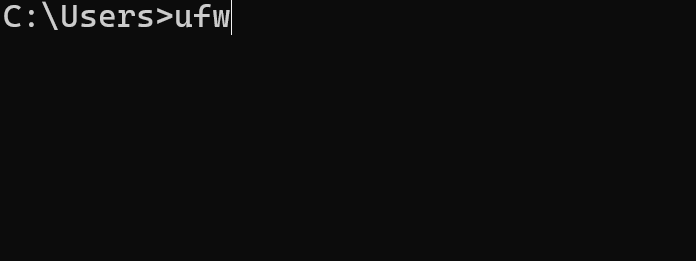Comprehensive Guide to the ufw Command in Linux
The ufw (Uncomplicated Firewall) command in Linux is a powerful yet user-friendly tool designed to manage firewall rules

The ufw (Uncomplicated Firewall) command in Linux is a powerful yet user-friendly tool designed to manage firewall rules. It serves as a front-end for iptables, simplifying the process of configuring and managing the built-in Linux kernel firewall. This guide will delve into the various aspects of ufw, from basic usage to advanced configurations, providing practical examples and tips to help you secure your Linux system effectively.
Introduction to ufw
The ufw command is designed to be an easy-to-use interface for managing firewall rules, particularly for users who may not be familiar with the complexities of iptables. It provides a command-line interface that simplifies the process of setting up and managing a firewall, making it accessible to both novice and experienced users.
Basic Usage of ufw
Enabling and Disabling ufw
Before you can start configuring firewall rules, you need to enable ufw. This can be done with the following command:
sudo ufw enable
This command activates the firewall and ensures it starts on system boot. Conversely, to disable the firewall, you can use:
sudo ufw disable
This command stops the firewall and prevents it from starting at system boot.
Checking Firewall Status
To check the current status of ufw, use:
sudo ufw status
This command will display whether the firewall is active and list the current rules.
Configuring Firewall Rules
Allowing and Denying Traffic
One of the primary functions of ufw is to allow or deny traffic on specific ports. For example, to allow incoming traffic on port 80 (HTTP), you can use:
sudo ufw allow 80
To deny incoming traffic on the same port, use:
sudo ufw deny 80
These commands update the firewall rules to allow or block traffic on the specified port.
Allowing Specific Services
ufw can also be used to allow traffic for specific services by name. For example, to allow SSH traffic, you can use:
sudo ufw allow ssh
This command is equivalent to allowing traffic on port 22, which is the default port for SSH.
Advanced Configurations
Default Policies
For enhanced security, it is recommended to set default policies that deny all incoming connections and allow all outgoing connections. This can be done with the following commands:
sudo ufw default deny incoming
sudo ufw default allow outgoing
These commands ensure that only explicitly allowed incoming connections are permitted, while all outgoing connections are allowed by default.
Custom Rules
ufw allows for the creation of custom rules to meet specific requirements. For example, to allow traffic from a specific IP address, you can use:
sudo ufw allow from 192.168.1.100
To allow traffic on a range of ports, use:
sudo ufw allow 8000:9000/tcp
These commands provide flexibility in configuring the firewall to suit various scenarios.
Managing Firewall Rules
Viewing and Deleting Rules
To view the current firewall rules, use:
sudo ufw status numbered
This command lists the rules with numbers, making it easier to manage them. To delete a specific rule, use:
sudo ufw delete <rule_number>
Replace <rule_number> with the number of the rule you want to delete.
Resetting ufw
If you need to reset ufw to its default settings, use:
sudo ufw reset
This command removes all existing rules and resets the firewall to its default state.
Logging and Monitoring
ufw provides logging capabilities to help monitor firewall activity. To enable logging, use:
sudo ufw logging on
This command enables logging of firewall events, which can be useful for troubleshooting and monitoring purposes.
GUI Tools for ufw
For users who prefer a graphical interface, ufw can be managed using GUI tools such as Gufw. Gufw provides an easy-to-use interface for configuring and managing firewall rules, making it accessible to users who may not be comfortable with the command line.
Conclusion
The ufw command in Linux is a versatile and user-friendly tool for managing firewall rules. Whether you are a novice or an experienced user, ufw provides a straightforward way to secure your Linux system. By following the examples and tips provided in this guide, you can effectively configure and manage your firewall to protect your system from unauthorized access and potential threats.
Citations:
[1] https://linuxsimply.com/ufw-command-in-linux/
[2] https://ioflood.com/blog/ufw-linux-command/
[3] https://wiki.ubuntu.com/UncomplicatedFirewall
[4] https://hostman.com/tutorials/how-to-set-up-a-firewall-with-ufw-on-ubuntu/
[5] https://www.linux.com/training-tutorials/introduction-uncomplicated-firewall-ufw/
[6] https://www.digitalocean.com/community/tutorials/ufw-essentials-common-firewall-rules-and-commands
[7] https://learnubuntu.com/ufw-commands/
[8] https://help.ubuntu.com/community/UFW
[9] https://askubuntu.com/questions/266414/want-some-advanced-configuration-with-ufw
[10] https://www.baeldung.com/linux/uncomplicated-firewall
[11] https://www.linode.com/docs/guides/configure-firewall-with-ufw/
[12] https://soufianebouchaara.com/mastering-ufw-tricks-and-tips/